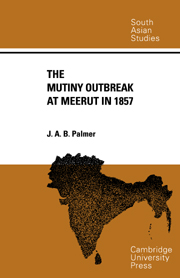Book contents
- Frontmatter
- Contents
- Introduction
- 1 CHAPĀTĪS
- 2 GREASED CARTRIDGES
- 3 THE PRESIDENCY DIVISION, FEBRUARY TO MAY
- 4 REGIMENTS AND OFFICERS AT MEERUT
- 5 MEERUT CANTONMENT IN 1857
- 6 THE FIRING PARADE OF 24 APRIL AND ITS SEQUEL
- 7 THE OUTBREAK: (a) The Native Infantry Lines
- 8 THE OUTBREAK: (b) The Native Cavalry Lines
- 9 THE OUTBREAK: (c) The Bazar Mobs
- 10 THE OUTBREAK: (d) The European Troop Movements and the European Lines
- 11 THE HANDLING OF THE EUROPEAN TROOPS
- 12 TO DELHI
- 13 CONCLUSIONS
- Notes and References
- Index
- Plan of Meerut Cantonment in 1857
11 - THE HANDLING OF THE EUROPEAN TROOPS
Published online by Cambridge University Press: 24 October 2009
- Frontmatter
- Contents
- Introduction
- 1 CHAPĀTĪS
- 2 GREASED CARTRIDGES
- 3 THE PRESIDENCY DIVISION, FEBRUARY TO MAY
- 4 REGIMENTS AND OFFICERS AT MEERUT
- 5 MEERUT CANTONMENT IN 1857
- 6 THE FIRING PARADE OF 24 APRIL AND ITS SEQUEL
- 7 THE OUTBREAK: (a) The Native Infantry Lines
- 8 THE OUTBREAK: (b) The Native Cavalry Lines
- 9 THE OUTBREAK: (c) The Bazar Mobs
- 10 THE OUTBREAK: (d) The European Troop Movements and the European Lines
- 11 THE HANDLING OF THE EUROPEAN TROOPS
- 12 TO DELHI
- 13 CONCLUSIONS
- Notes and References
- Index
- Plan of Meerut Cantonment in 1857
Summary
The Government of India, on 28 June 1857, removed General Hewitt from the command of the Meerut Division. That is at least some justification for the opinion that the handling of the European troops on the evening of 10 May was not creditable. However, Wilson was left to fight another day; and the decision to remove Hewitt was taken by Sir Patrick Grant in Calcutta, when he certainly did not have full information about all the circumstances on the evening of 10 May. So his decision is not conclusive. It cannot have been uninfluenced by the outcry against the Meerut commanding officers which rose immediately and grew louder as the disasters of May and June 1857 accumulated, disasters for which these officers at Meerut were held indirectly responsible in addition to their alleged defaults on that evening itself. Every historian has added his voice to the chorus of blame, but in detail often injudiciously and in general perhaps excessively. At any rate, the fair and right way is to scrutinise with care the steps which were taken that evening and the charges based upon them.
The first and most sweeping charge is that of delay in bringing the European troops into action. This is given some colour by taking the time limits as about 5 p.m., the first outcry in the bazar; and 8.30 p.m., the arrival of the Carabiniers on the native parade ground. Those limits are, of course, too wide.
- Type
- Chapter
- Information
- The Mutiny Outbreak at Meerut in 1857 , pp. 106 - 118Publisher: Cambridge University PressPrint publication year: 1966



